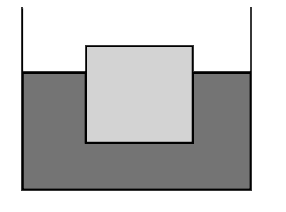Why an ice block melt at the bottom first?
To understand why an ice block melts at the bottom first, we can break down the explanation into several steps:
1. Understanding Ice and Water Density:
- Ice is less dense than water, which is why it floats on the surface of a lake or any body of water. This property is crucial in understanding the melting process.
2. Heat Sources:
- Ice can melt due to two main sources of heat:
- Solar Radiation: The sunlight warms the surface of the ice, causing it to absorb heat and start melting from the top.
- Conduction from Water: The water beneath the ice is at a higher temperature than the ice. Heat is conducted from the warmer water to the colder ice, causing it to melt from the bottom.
3. Rate of Melting:
- The rate at which the ice melts from the bottom is significantly faster than from the top. This is because the water below the ice is typically at a temperature above 0°C, while the top surface of the ice may only receive limited heat from the sun.
4. Dominance of the Bottom Melting Process:
- Since the melting process from the water below is more efficient and faster than the melting from the sun's rays, the ice block primarily melts from the bottom. This leads to the observation that the ice appears to be melting from the bottom first.
5. Conclusion:
- Therefore, the combination of the warmer water beneath the ice and the relatively slower warming from the sun results in the ice block melting predominantly from the bottom.
- Ice is less dense than water, which is why it floats on the surface of a lake or any body of water. This property is crucial in understanding the melting process.
- Ice can melt due to two main sources of heat:
- Solar Radiation: The sunlight warms the surface of the ice, causing it to absorb heat and start melting from the top.
- Conduction from Water: The water beneath the ice is at a higher temperature than the ice. Heat is conducted from the warmer water to the colder ice, causing it to melt from the bottom.
- The rate at which the ice melts from the bottom is significantly faster than from the top. This is because the water below the ice is typically at a temperature above 0°C, while the top surface of the ice may only receive limited heat from the sun.
- Since the melting process from the water below is more efficient and faster than the melting from the sun's rays, the ice block primarily melts from the bottom. This leads to the observation that the ice appears to be melting from the bottom first.
- Therefore, the combination of the warmer water beneath the ice and the relatively slower warming from the sun results in the ice block melting predominantly from the bottom.
Topper's Solved these Questions
- HEAT AND THERMAL EXPANSIONBOOK - PHYSICS GALAXY - ASHISH ARORACHAPTER - HEAT AND THERMAL EXPANSIONEXERCISE - CONCEPTUAL MCQs SINGLE OPTION CORRECT
15 Videos
- HEAT AND THERMAL EXPANSIONBOOK - PHYSICS GALAXY - ASHISH ARORACHAPTER - HEAT AND THERMAL EXPANSIONEXERCISE - NUMERICAL MCQs SINGLE OPTIONS CORRECT
81 Videos
- HEAT AND THERMAL EXPANSIONBOOK - PHYSICS GALAXY - ASHISH ARORACHAPTER - HEAT AND THERMAL EXPANSIONEXERCISE - PRACTICE EXERCISE
40 Videos
- GEOMETRICAL OPTICSBOOK - PHYSICS GALAXY - ASHISH ARORACHAPTER - GEOMETRICAL OPTICSEXERCISE - Unsolved Numerical Problems
107 Videos
- HEAT TRANSFER BOOK - PHYSICS GALAXY - ASHISH ARORACHAPTER - HEAT TRANSFER EXERCISE - Unsolved Numerical Problems for Preparation of NSEP,INPhO&IPhO
66 Videos
Similar Questions
Knowledge Check
When ice melts at 1∘C :
Aan increase in entropyBa decrease in enthalpyCa decrease in free energyDprocess is spontaneousWhen ice melts into water, entropy
ABecomes zeroBDecreasesCIncreases in randomness of surrroundings equals ito the decreases in randomness of systemDRemains sameThe opposite faces of a cubical block of iron of cross-section 4 square cm are kept in contact with steam and melting ice. Calculate the quantity of ice melted at the end of 10 minutes. k for iron =0.2CGS units.
A300gB150gC75gD450g
The rate at which ice melts is more at the top when compared to the bottom of the blacier. Explain whether the statement is true capacities.?
View SolutionA cubical ice block of side length 'a' is floating in water in a beaker. Find the change in height of the centre of mass of (water+ice) system when the ice block melts completely. It is given that ratio of mass of water to mass of ice originally in the containe is 4:1.

View SolutionWhy does ice melt showly at higher altitudes?
View SolutionWhen glass of water is freezed, formation of ice starts from the top layer but melting of ice starts from the bottom. Justify.
View SolutionA bullet of mass 10 g moving with a speed of 20m/s hits an ice block of mass 990 g kept on a frictionless floor and gets stuck in it. How much ice will melt if 50% of the lost kinetic energy goes to ice?
(Temperature of ice block =0∘C.)
View Solution
